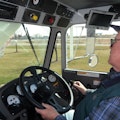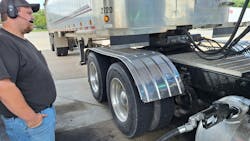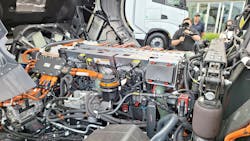Construction fleet managers rank carbon reduction and sustainability high on their list of challenges. Their truck fleets are facing new, stricter limits on exhaust emissions, and regulators are demanding drastic and expensive changes in the types of equipment that they buy, maintain, and operate.
Cheers and consternation are resulting from stricter exhaust emissions limits published by federal and state regulators and due to take effect starting in 2027 and tightening in 2030. Aimed primarily at further cutting nitrogen oxide (NOx) emissions that form smog, the limits will increase truck acquisition costs.
Several lawsuits are challenging the regulations, and members of Congress have introduced bills to block them. The American Trucking Associations, the Owner-Operator Independent Drivers Association, and other groups say in their suit that meeting the new standards will be too expensive, especially for small fleets and owner-operators, running many out of business.
“The post-2030 targets remain entirely unachievable,” said Chris Spear, ATA’s CEO. “Any regulation that fails to account for the operational realities of trucking will set the industry and America’s supply chain up for failure.”
Meanwhile, truck manufacturers report that some fleets have begun “pre-buying” current vehicles to avoid the ’27 versions. This recalls pre-buys of 2007 and 2009, among others, that preceded implementation of previous EPA emissions regulations. Those resulted in frenzied production of new trucks in the months leading up to effective dates, then steep slumps accompanied by large worker layoffs. Truck builders hated those periods.
As before, the principal regulatory authorities are the federal Environmental Protection Agency and the California Air Resources Board. CARB wants to end sales of trucks with internal combustion engines by 2036 and all diesel operations by 2050. Seventeen other states plus the District of Columbia follow California’s lead in whole or part, or are considering it.
To be sure, CARB has not completely turned its back on internal combustion engines. The Carl Moyer Grants program, begun in 1998, offers money to operators of trucks and off-road machinery to modernize the power plants in their equipment. CARB said that as of 2021, it had granted more than $1.3 billion since the start of the program, resulting in reduction of 202,673 tons of NOx and 7,456 tons of particulate matter. The program, administered by local and regional air-quality districts, is still active.
What is the Clean Trucks Plan?
The latest rules from the federal EPA began taking effect in March and are part of what EPA calls its Clean Trucks Plan, announced in 2021. It is divided into three phases governing different vehicles and types of emissions. They slash the amount of greenhouse gasses, primarily carbon dioxide (CO2), emitted by diesel-powered heavy-duty vocational and on-highway trucks and buses.
Michael Regan, the agency’s administrator, said calculations show that new trucks would save operators $3.5 billion in fuel and other costs from 2027 to 2032, paying for themselves in two to four years. And the 2022 Inflation Reduction Act provides tax credits to subsidize the purchase price of new electric vehicles.
Overall, EPA’s rules will require truck manufacturers to sell more battery-electric and other zero-emission vehicles, according to analyses. These can cost two to three times more than diesel trucks, and although government subsidies can eliminate some of the incremental costs, all but the most progressive fleets have been reluctant to buy them. Battery-electric trucks in particular have come in for criticism because public charging stations are few and far between, so fleets will have to acquire and install their own chargers—a complex, expensive, and time-consuming project in every case, experts have warned.
Utilities, EVs not ready for construction applications
Moreover, critics say that electric utilities do not have the generating and distribution capacity to power the chargers, although some say they do. And in some areas, new data centers will demand huge amounts of electricity, as will microchip-manufacturing plants being built in the Midwest. In a few cases, progressive truck operators, aided by truck builders, are installing their own generating equipment, usually solar panels but sometimes wind turbines.
Heavy-duty battery-electric trucks are available from major builders for local and regional freight hauling. And there are a few medium-duty electric trucks that could be used in construction. But except for trash collection, there are no heavy-duty electric vocational trucks on the market, and they won’t appear until late in this decade or into the 2030s, predicts the North American Council for Freight Efficiency, an independent equipment evaluation organization.
That might or might not be in time to meet one of the EPA’s recent mandates: Starting in 2027, an increasing percentage of new vocational trucks must be zero-emission products, though the initial number is reduced from previous proposals. By 2032, 30% of vocational trucks must be zero emitters. These would have to be electric trucks, with power coming from storage batteries or fuel cells, the latter running on hydrogen. It will also be permissible to use internal combustion engines fueled by hydrogen, now generated from water by electrolysis and steam-formulated from natural gas.
The more zero-emission trucks produced, however, the fewer diesel-powered trucks that would be available, industry sources complain. And diesels will be needed to carry the transportation industry into the 2030s. Engine builders have spent hundreds of millions of dollars developing diesel products that meet the 2027 limits, plus electric powertrains to meet regulatory demands of the 2030s. So they support the new rules.
Current-model diesels are so clean that their exhaust emissions can barely be measured, according to the Engine Technology Forum, which advocates for their continued use. “As a result of progressively more stringent emissions standards over the last three decades, engines have undergone a transformation that enables them to achieve near-zero levels of emissions today,” the group states. “Internal combustion engines now meet the most stringent U.S. EPA emissions standards that require emissions of particulate matter, nitrogen oxides, and hydrocarbons to be near-zero levels.
“Starting in 2027, nitrogen oxide emissions from commercial trucks will have to be 82.5% lower than the current generation of vehicles (from 0.20 to 0.035 gram per brake horsepower-hour),” the forum’s statement continues. “In addition, new requirements increase the useful life for emissions compliance from 435,000 miles to 650,000 miles and boost warranty coverage from 100,000 miles to 435,000 miles.”
In the longer term, regulators want to do away entirely with the burning of fossil fuels, jumping to zero-emission vehicles. Yet fossil fuel use can be reduced by substituting biofuels—which blend oils from plants and animals with petroleum—or using straight bio fuels in internal combustion engines.
Fuel Taxes and the Highway Trust Fund
Repeal the 12% FET?
A move is afoot to repeal the 107-year-old federal excise tax on new heavy-duty trucks. The 12% FET adds as much as $22,000 to the price of a new heavy-duty diesel truck, or $50,000 for an electric truck.
Separate bipartisan bills that would repeal the FET were introduced in March of 2023, but they have been stalled as members of Congress grapple with other issues.
The 12% FET placed on heavy trucks, truck chassis, bodies, and trailers is the highest excise tax charged on any product, according to the Association for the Work Truck Industry.
The American Transportation Research Institute plans to do a cost-benefit analysis on the tax.
The Federal Excise Tax (right) is among the sources of money for the federal Highway Trust Fund, which supports the building and repair of roads and bridges. Other funds come from motor-fuel taxes on gasoline and diesel. If those fuels are eventually eliminated, the revenue they generate will also dry up. Congress needs to find other sources of money to support infrastructure work, study groups say. Zero-emissions vehicles do not pay such taxes, but they could through new registration and highway-use fees.
“The revenue damage done to the Highway Trust Fund should be at least a part of the debate when Congress is discussing advancing electric vehicles,” Jeff Davis, senior fellow at the Eno Center for Transportation, told senators at a recent hearing. “It is long past time for Congress to either strengthen, or else abandon, the user-pay model for surface transportation since electrification is accelerating the demise of fossil fuel taxes, and the underlying goal of zero-emission transportation by 2050 would inherently eliminate fossil fuel taxation as a revenue stream.”
Strong vocational truck sales
Times are both good and not so good for trucking and truck manufacturing, said Steve Tam, VP of ACT Research. Freight haulers find themselves with too much truck capacity while cargo shipments are down. He puts overcapacity at 4%, which might sound minor except that 4% of an estimated 2.97 million highway tractor-trailers is a considerable number. So those truckers have cut back on ordering new highway tractors, and as of July, orders totaled 160,000 units for the year, down 23% from last year.
“Vocational sales are another matter,” Tam said. “Orders for them totaled 69,000 trucks, up 9%. Growth is peaking right now (in mid-summer), and there’s a pretty healthy backlog because the industry decided to satisfy the tractor side. In June they built enough to support a 400,000 year, when 240,000 to 250,000 is more realistic. There may be a little switch to vocational production; the backlog now is 40,000 orders and five or five and a half months.”
One prominent component maker is enjoying healthy business from this trend. “Funding and spending for infrastructure projects has led to extraordinary demand for Class 8 vocational vehicles in North America,” David Graziosi, chairman and CEO of Allison Transmission, announced during the summer. “With Allison’s share in 2023 at roughly 80% in these vocational vehicles, we are seeing unprecedented demand for our 3000 Series and 4000 Series on-highway products.”
Another factor is a younger workforce not familiar with manual transmissions, Graziosi said. Retirement of experienced drivers has required hiring of young people who grew up driving automatic transmissions. Training them on manual gearboxes would take time, and meanwhile equipment would get rough use. Switching to automatics is a quick and cost-effective solution, and that has boosted the fortunes of Allison and other makers of self-shifting gearboxes.
About the Author

Tom Berg
Tom Berg is widely acknowleged as one of the top truck writers in the industry. He has covered construction for more than 34 years, and has test-driven well over 150 trucks for Construction Equipment.


